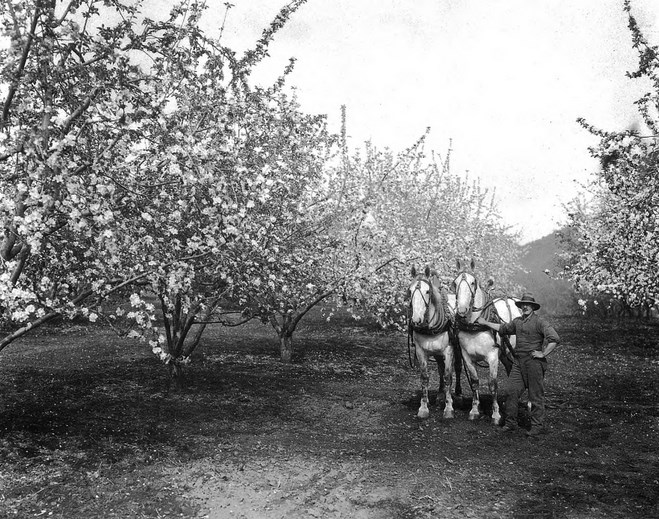
Image Credit: Submitted/BC Fruit Growers' Association
January 14, 2024 - 8:00 AM
The Okanagan recorded one of the driest years on record in 2023 and with no end in sight, the region could be facing a drought of the magnitude of the 1930s that contributed to a global depression.
While the Okanagan Basin Water Board would love water users to be more conservation conscious, the reality is there are systems in place to protect both residents and growers from looming shortages, just as there were almost 100 years ago.
What growers were not insulated during the Great Depression was the shortage of money to buy their produce, so a lot of their fruit and veggies were dumped and left to rot despite people literally starving across the country.
“My grandparents grew onions out in Ellison,” Kelowna historian Bob Hayes told iNFOnews.ca. “I remember my mom saying for at least one year – probably several years – there was just no market for the product because there was no money.
“I remember my mother saying there was a big dump, I think near the corner of Leathead Road and the highway – that’s where the drive-in theatre used to be – and that’s where the local people would take their produce and dump it.”
He heard of fruit growers who sent their crop to packing houses only to get billed at the end of the season because it didn’t sell so some of them chose chose to dump the fruit instead.
“With the drought – where we live we’re semi-desert anyway – we traditionally made good use of the water because we don’t have much to waste,” Hayes said. “My mom’s brother was farming in that era and he had an orchard and I don’t recall him complaining about a lack of a crop, there was just no demand for it.”
Okanagan Lake had its lowest inflows in history in 1929, followed by two years with drought conditions.
READ MORE: Is 2024 the year Okanagan Lake floating bridge becomes a suspension bridge?
The saving grace for the region was in the early 1900s mostly English money was used to build extensive irrigation systems bolstered by upland storage lakes. That allowed fruit and vegetables to be grown through the drought of the 1930s.
The vegetables were often planted between rows of new fruit trees to provide income until the trees produced a crop.
Once the trees were big enough to yield marketable fruit they would overshadow and replace the vegetable beds.
There were big vegetable fields near what is now Parkinson Recreation Centre in Kelowna. Crops included things like tomatoes to supply two canneries, peppers, onions, beans and eggplant.
“From the time tomatoes started ripening at the end of July to the first killing frost – possibly to mid-November – the air was just pervaded with this tomato smell,” Tilman Nahm told iNFOnews.ca.
He was born in Kelowna in 1931, worked most of his life as a telegraph operator and had two orchards in the Benvoulin area.
His memories don’t go back quite as far as those really dry early years of the Depression but he can remember back to about 1935 when he went fishing in Mill Creek. There were numerous dams in the area to provide water to the farms.
“There was so much water being taken out by the dams along the creek that it was just a little trickle in Mill Creek going from pool to pool,” Nahm said.
Later, when he worked as a telegraph operator, he would see the manifests showing the fruit and vegetables being shipped out, but that was past the Depression days.
“Fruit growers were really under stress,” Nahm said. “The vegetable growers, there always seemed to be a pretty good market for them.”
It was back in 1933 when fruit growers adopted the Cent a Pound or on the Ground slogan and went on strike for better prices.
That wasn’t triggered by any local drought because the 1933 apple crop was 1,000 rail cars bigger than in 1932.
The BC Fruit Grower’s Association history of that time is all about conflicts between growers and marketing associations as being key to that dispute.
While the Depression likely contributed heavily to the low prices and the need for growers to demand enough return to at least cover their costs of production, a shortage of water to grow those crops was not an issue.
Similarly, if that drought is replicated in the next couple of years, those century-old irrigation systems – which, of course, have been upgraded – will ensure plenty of water for the current generation of growers.
To contact a reporter for this story, email Rob Munro or call 250-808-0143 or email the editor. You can also submit photos, videos or news tips to the newsroom and be entered to win a monthly prize draw.
We welcome your comments and opinions on our stories but play nice. We won't censor or delete comments unless they contain off-topic statements or links, unnecessary vulgarity, false facts, spam or obviously fake profiles. If you have any concerns about what you see in comments, email the editor in the link above. SUBSCRIBE to our awesome newsletter here.
News from © iNFOnews, 2024